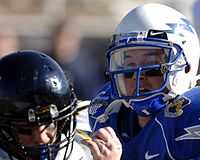Eye black

Eye black is a grease applied under the eyes to reduce glare. It is often used by football, baseball, and lacrosse players, where sunlight or stadium lights can impair vision of an airborne ball.
It is a form of functional makeup or war paint.
Varieties
- Anti-glare face strips that emulate the grease are also commonly used.
History
One of the earliest known instances of a player wearing eye black is baseball legend Babe Ruth, who, in or around the 1930s, used the grease in an attempt to reduce sun glare. According to Paul Lukas of ESPN.com, eye black caught on with American football player Andy Farkas.[1] He also states that the original eye black was made from burned cork ashes.
Effectiveness
As of 2013, further study is needed to conclusively determine eye black effectiveness.
2003 Study
A 2003 study by Brian DeBroff and Patricia Pahk tested whether black eye grease actually had anti-glare properties. The subjects of the study were divided into three groups: wearers of eye black, wearers of anti-glare stickers, and wearers of petroleum jelly. The subjects' vision was tested using an eye chart while being exposed to natural sunlight.
The study concluded that eye black reduced glare of the sun and improved contrast sensitivity, whereas commercial anti-glare stickers and petroleum jelly (the control substance) were found to be ineffective.[2]
However, the study was flawed because the subjects were aware of which substance was applied, introducing demand bias, i.e., the test subjects could have unconsciously changed their responses during testing based on the fact that they knew which substance they were wearing. Also, the petroleum jelly could have introduced glare that would not occur on natural skin and the study did not test a control condition of natural skin.
New Hampshire Study
A study by Benjamin R. Powers at University of New Hampshire,[3] which improved on DeBroff's methodology, found eye black to reduce glare from the sun in females and in those whose eye-color was not blue. The study also tested males and blue-eyed subjects. However, the results were not statistically significant (probably due to a smaller sample size of those test subjects). Some testing was also performed indoors under artificial lighting (when inclement weather prohibited outdoor testing). However, those results showed little difference and were not statistically significant. The Powers study was not a double-blind study because those in contact with the test subjects knew which substance was applied. Also, the eye tests were performed at a distance of only 1.15 meters.
Mythbusters Test
On an episode of Mythbusters, Adam Savage and Jamie Hyneman tested whether eye black reduces glare. It failed to do so. They also added a hat to help reduce the glare and concluded that this theory is plausible.
Messages in Eye Black
Some athletes, particularly at the college level, began a practice of placing short messages on their eye black, most notably Tim Tebow who used Bible verse references. However, this practice was banned on April 14, 2010, when the NCAA Playing Rules Oversight Panel (PROP) approved a proposal effecting "that players are not allowed to have any symbols or messages on their eye black starting in the 2010 season."[4]
References
- ↑ Lukas, Paul (2006-11-21). "The evolution of eye black. It has also been manufactured, sometimes with a sports team logo printed on them". ESPN Page 2.
- ↑ Brian M. DeBroff and Patricia J. Pahk (July 2003). "The Ability of Periorbitally Applied Antiglare Products to Improve Contrast Sensitivity in Conditions of Sunlight Exposure". Archives of Ophthalmology 121 (7): 997–1001. doi:10.1001/archopht.121.7.997. PMID 12860804.
- ↑ Benjamin R. Powers (2005). "Why Do Athletes Use Eye Black?". University of New Hampshire Inquiry.
- ↑ Johnson, Greg (2010-04-15). "PROP approves wedge-blocking proposal". The NCAA News. Retrieved 2010-04-16.
External links
- The Power of Darkness | Popular Science
- Eye Black Used to Cut Glare, or Turn Up Spotlight - New York Times